中国气象学会主办。
文章信息
- 白永清, 祁海霞, 赵天良, 杨浩, 刘琳, 崔春光. 2018.
- BAI Yongqing, QI Haixia, ZHAO Tianliang, YANG Hao, LIU Lin, CUI Chunguang. 2018.
- 湖北2015年冬季PM2.5重污染过程的气象输送条件及日变化特征分析
- Analysis of meteorological conditions and diurnal variation characteristics of PM2.5 heavy pollution episodes in the winter of 2015 in Hubei province
- 气象学报, 76(5): 803-815.
- Acta Meteorologica Sinica, 76(5): 803-815.
- http://dx.doi.org/10.11676/qxxb2018.029
-
文章历史
- 2017-10-20 收稿
- 2018-04-09 改回
2. 南京信息工程大学中国气象局气溶胶-云-降水重点开放实验室, 南京, 210044
2. Key Laboratory for Aerosol-Cloud-Precipitation of China Meteorological Administration, Nanjing University of Information Science and Technology, Nanjing 210044, China
研究气象因子对灰霾天气的影响,进而科学、有效地预测和动态调控污染物排放以治理灰霾天气,是十分重要和紧迫的研究课题(吴兑,2012)。大气气溶胶浓度变化既受控于大气颗粒物及其前体物的排放,也受到多尺度气象条件及气候变化的影响(Kan, et al,2012;Tai, et al,2012;Zhu, et al,2012;刘瑞金等,2017)。气象条件对气溶胶污染形成、分布、维持与变化的作用显著,导致中国霾呈区域性分布的特点(张小曳等,2013)。在青藏高原东侧特殊大地形背景下形成类似静稳天气的“避风港”效应,引发了中国东部大范围霾天气变异(徐祥德等,2015)。异常的静稳天气、均压场、小弱风、强而厚的逆温层和低混合层高度等极其不利于污染物扩散的局地气象条件是重度霾形成的外部条件(王跃思等,2014;张人禾等,2014;缪育聪等,2015)。持续出现的稳定天气形势是导致中国东部重污染天气的主要气象原因(尉鹏等,2015)。此外,大气污染物传输也是空气污染形成的重要原因(Kim, et al,2012;吴兑等,2014;薛文博等,2014;Miao, et al,2017;周述学等,2017),细颗粒物传输影响范围大、传输距离远,具有明显跨界传输效应(Squizzato, et al,2012;Lang, et al,2013;Wu, et al,2013;Guo, et al,2017)。已有研究表明,静稳天气京津冀地区仍旧存在显著的区域输送,并直接造成京津冀地区PM2.5浓度的累积(王自发等,2014)。气象条件为气溶胶粒子输送、滞留及其与本地污染粒子的叠加提供了环流背景(姚日升等,2017)。北京地区受中东部地区在南风作用下的污染输送(Zhang, et al,2015),太行山前西南风是北京边界层外来污染物的输送通道之一(苏福庆等,2004)。香港东部一次重污染灰霾天气过程是受冷空气携带的高浓度气溶胶影响(吴兑等,2011)。上海潜在源区除长三角一带外,山东、河北、河南等地对于上海城区颗粒物污染亦有一定贡献(安静宇等,2014;李莉等,2015)。福州PM2.5污染过程中并未出现大气边界层逆温结构,有利于区域传输的污染物从上层大气到达近地面从而加重污染(蒋永成等,2015)。武汉和南京在地面锋线到达以后PM2.5浓度快速增长,1000-950 hPa高度层上偏北风的侵入带来上风向的大气污染物,同时在垂直方向上锋区内的稳定性层结抑制了大气污染物的扩散(王继康等,2017)。另外,关于日间大气颗粒物浓度峰值成因的问题关注不多,且多归咎为人为活动和本地源变化的影响(赵晨曦等,2014),同时局地地面风场对污染有加重效应(张雅斌等,2016),重污染日的PM2.5浓度早上峰值出现时间推后(石春娥等,2017),但缺乏相关影响机制的解释。
近年来,长江中游大气气溶胶浓度呈现上升趋势(谭成好等,2015;李嘉伟等,2016),成为中国霾污染一个潜在的重灾区。长江中游流域大气环境污染形势严峻(Zhang, et al,2012),区域细颗粒物浓度与较高相对湿度共同影响和制约大气能见度变化,高湿天气和高浓度污染使区域能见度显著恶化(Ding, et al,2014;白永清等,2016a)。随着长江经济带的发展和长江中游城市群的建设,中部地区城市化快速发展的同时,大气环境污染问题也日益突出,而针对长江中游气溶胶污染的研究开展得相对较少。在国务院发布的《长江经济带发展规划纲要》中,湖北省被赋予引领长江中游城市群发展、打造中部崛起之核心增长极的重任,其战略地位愈发重要。本研究关注了2015/2016年冬季湖北PM2.5重污染过程的“非静稳”气象输送条件,探讨了该地区PM2.5浓度日变化双峰结构的天气成因,为区域重污染天气预报及有效治理颗粒物污染提供参考,服务于长江中游社会经济发展。
2 数值模拟方案设计区域中尺度大气化学模式WRF/Chem(Grell, et al,2005)实现了大气动力学与大气化学的双向耦合,为化学模式在线提供污染物输送、干湿沉降、气相化学、气溶胶形成、辐射和光分解率、气溶胶参数化等化学过程,在中外大气环境研究中被广泛使用(贾星灿等,2012;Kumar, et al,2014;Zhong, et al,2016;Guo, et al,2016;赵秀娟等,2016)。采用华中区域环境气象数值预报系统(白永清等,2016b)框架,以湖北省为中心,设置双层嵌套区域27 km/9 km,d01覆盖东亚大部分地区,d02覆盖华中地区。主要物理化学参数化方案为:YSU边界层方案(Hong, et al,2006)、RRTM长波辐射方案(Iacono, et al,2008)、Goddard短波辐射方案、Noah LSM陆面模式(Chen, et al,2001),RADM2气相化学、MADE/SORGAM气溶胶化学机制。
WRF模式对近地面风速模拟往往有系统性正偏差,风场偏差直接影响污染物浓度预报。周广强等(2016)分析华东区域WRF/Chem对PM2.5预报偏差时指出,重污染时近地面风速预报偏大,垂直扩散能力偏高,偏大的风速造成污染物消散速度偏快,从而使污染物浓度预报偏低。城市化使得地表粗糙度发生很大变化,利用经验修订WRF模式地表粗糙度因子,调试边界层方案的摩擦速度参数,能够有效订正地面风速系统偏差(Zheng, et al,2015)。在湖北本地化应用中,对WRF边界层的摩擦速度项乘以1.8,有效降低了地面风速系统正偏差。
采用清华大学2012年亚洲地区0.25°×0.25°分辨率人为排放源清单(Li, et al,2015)。Hu等(2015)利用反演模式方程对源清单进行校正,以预报误差最小化为约束条件,通过CMAQ-DDM-3D算法确定排放源敏感性系数(Hu, et al,2014),显著提高了空气质量模式预报水平。文中模拟方案也采用类似Hu等(2014, 2015)排放源清单校正原则,利用WRF/Chem进行2个月反算,以湖北省空气质量预报误差最小化为约束条件,反复测算确定主要物种排放源强度(敏感性系数),提高空气质量预报准确率。引入污染物观测资料的约束,以弥补排放源清单时滞及其他不确定性的差距。
为研究湖北省PM2.5区域传输特征,设置了两种不同排放情景:(1)基础排放源情景,记为base;(2)关闭湖北省域内人为排放源,设计湖北省域内零排放情景试验(Xing, et al,2011;Guo, et al,2016),在相同条件设置下模拟,记为non-local sources,表示污染输送。
模拟起始时间设置为2015年12月1日12时,终止时间为2016年1月31日12时(世界时),采用全球模式NCEP/GFS(0.5°×0.5°分辨率)每日12时(世界时)预报的前36 h作为驱动,每6 h更新一次侧边界,运用模式张弛逼近四维同化过程,使模式输出结果张弛逼近到“观测”。最后剔除12月1日12时-2日12时(世界时)模式的起转时间,对2015年12月2日-2016年1月31日逐时模拟结果进行分析。将模式输出结果插值到湖北省17个城市站点,以17个城市平均值代表湖北省平均状况。由湖北省环境监测中心站提供城市站点相同时间段PM2.5浓度实况监测数据,湖北省气象信息与技术保障中心提供同时段17个常规站气象观测数据。
3 重污染过程的“非静稳”气象输送条件 3.1 观测分析湖北地区冬季重污染过程具有“非静稳”边界层气象特征。图 1给出江汉平原荆门2015年12月2日-2016年1月31日逐时实况PM2.5浓度、10 m风速和风向组合玫瑰图。可以看出,偏北风占主导、较大风速条件对应PM2.5高浓度,当地面偏北风风速为8-10 m/s时,PM2.5浓度达到300 μg/m3以上极值。表明该地区重污染过程明显由偏北风输送造成,以传输性爆发污染为主,小弱风很难达到重度以上污染。

|
| 图 1 2015年12月2日-2016年1月31日荆门PM2.5浓度(色阶)、10 m风速(圈线,单位:m/s)和风向组合玫瑰图 Figure 1 The combination rose of PM2.5 concentration (shadings)、10 m wind speed (circle line) and direction in Jingmen from 2 December 2015 to 31 January 2016 |
图 2给出2016年11月15日荆门重污染过程风廓线雷达探测边界层风场结构,可见在重污染爆发和维持阶段,800 m以内一直持续较强偏北风,边界层低空输送条件良好,为典型传输型污染过程。图 3给出2016年1月17日08时-21日24时(北京时,下同)武汉污染过程微波辐射计探测边界层温度、湿度结构特征,可见17-19日两次重污染爆发和维持阶段,低空整层均没有显著逆温,高湿度层下压接近地面,至21日PM2.5浓度降低以后才出现明显逆温层和高湿度层,这有别于典型重污染过程的逆温特征。
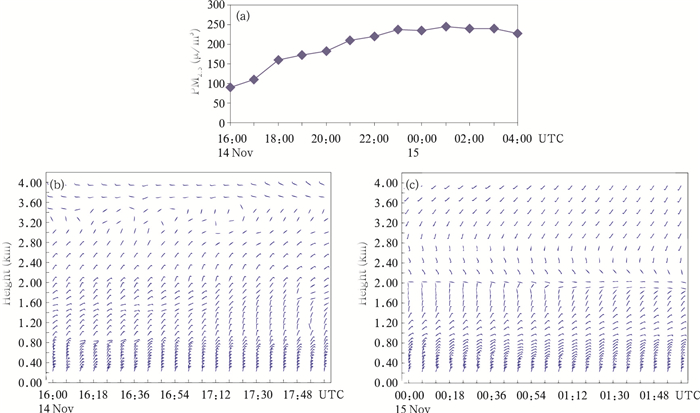
|
| 图 2 2016年11月14日16时-15日04时(世界时)荆门观测PM2.5浓度(a)及14日16-18时(b)和15日00-02时(c)风廓线雷达探测边界层水平风速(风矢)垂直结构 Figure 2 Observed PM2.5 concentration from 16:00 UTC 14 to 04:00 UTC 15 November 2016 (a), and vertical structure of horizontal wind speed (barbed arrow) in the boundary layer observed by wind profiler radar in Jingmen from 16:00 UTC 14 to 18:00 UTC 14 November (b), and from 00:00 UTC to 02:00 UTC 15 November 2016 (c) |
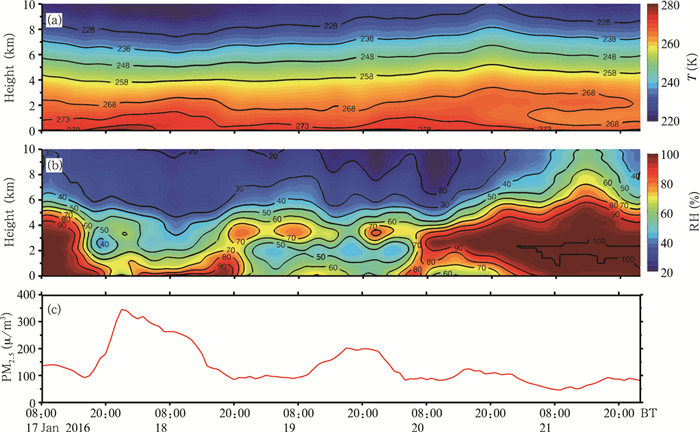
|
| 图 3 2016年1月17-21日武汉微波辐射计探测边界层温度(a)、相对湿度(b)垂直结构及同期观测PM2.5浓度(c) Figure 3 Vertical structure of temperature (a) and relative humidity (b) in the boundary layer observed by microwave radiometer, and observed PM2.5 concentration (c) in Wuhan from 17 to 21 January 2016 |
综合以上观测分析表明,湖北冬季以传输性爆发污染为主,江汉平原PM2.5极值300 μg/m3以上对应10 m风速可达到8-10 m/s,边界层传输条件良好,低空无明显逆温层,低层和近地面层有较强偏北风输送,有别于华北地区“静稳”边界层触发的累积性爆发污染。
3.2 模拟分析利于WRF/Chem模拟2015年12月2日-2016年1月31日湖北冬季重污染过程边界层特征。图 4给出湖北省实况和模拟PM2.5浓度(base、non-local sources)逐时序列。经检验,base试验模拟湖北PM2.5浓度与实况相关系数(R)为0.71,模拟偏差(MB)为-0.46 μg/m3、标准化偏差(NMB)为-0.5%、标准化平均绝对误差(NME)为21.6%、均方根误差(RMSE)为26 μg/m3,表明模拟结果合理,有较高可信度。由图可见,PM2.5输送(non-local sources)与实况变化趋势较为一致,且实况峰值过程均对应输送峰值,这表明区域传输决定污染变化趋势,重污染过程表现明显传输特征,湖北冬季以传输性爆发污染为主。

|
| 图 4 2015年12月2日-2016年1月31日湖北省实况PM2.5(observed)及模拟PM2.5(base、non-local sources)浓度的时间序列 Figure 4 Time series of PM2.5 concentration from observations, base simulation (base) and zero-emission scenario simulation (non-local sources) in Hubei province from 2 December 2015 to 31 January 2016 |
筛选2015年12月2日-2016年1月31日湖北重污染时次(筛选出10%的异常样本,对应实况PM2.5>130 μg/m3),对10%异常样本合成(该2个月时段内的距平),分析湖北省重污染形成的输送条件。
图 5模拟合成PM2.5浓度距平和10 m异常风速场(U、V分量距平),可见,重污染过程,长江中下游及北部地区偏北风异常偏强,长江中游以南地区风速减缓,受此影响污染物由北向南输送,在长江中游平原地区堆积,湖北、湖南、江西各省PM2.5浓度均为正距平。污染物输送堆积与大尺度风场作用有关,图 6给出湖北PM2.5输送(non-local sources)与区域10 m风速的相关矢量场(徐祥德等,2005)。图中,偏北方向矢量表示风场对湖北PM2.5输送作用,输送气流主要来源豫皖苏等地区,且湖北北部边界风速越大,越有利污染输送。偏南方向矢量起到阻挡北方污染气流作用,冬季风在华南、东南风速减缓越小,越利于污染物在长江中游地区滞留堆积。
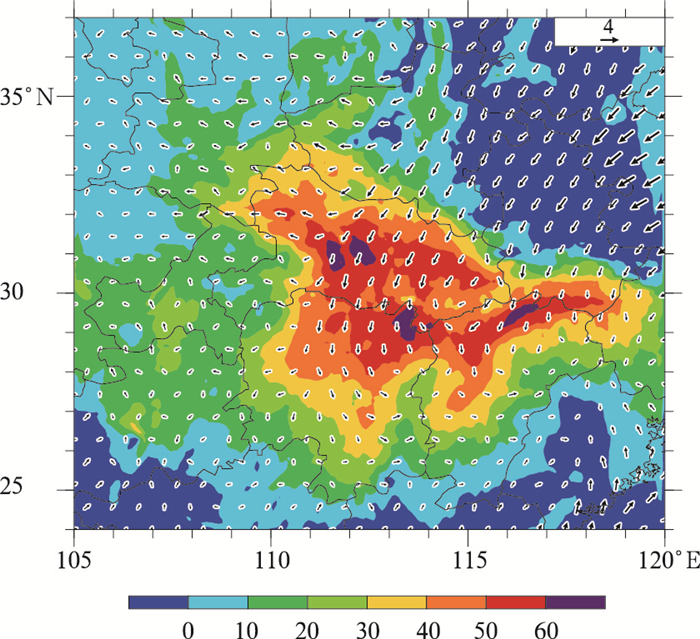
|
| 图 5 湖北重污染过程模拟合成的PM2.5浓度距平(色阶,单位:μg/m3)和10 m异常风速场(矢线,单位:m/s) Figure 5 Numerical simulation synthesis of PM2.5 anomaly (shadings, unit: μg/m3) and 10 m wind speed anomaly (vectors, unit: m/s) during heavy pollution process in Hubei province |

|
| 图 6 2015年12月2日-2016年1月31日模拟的湖北PM2.5(non-local sources)输送浓度与10 m风速相关矢量场(阴影区通过95%显著性t检验) Figure 6 Distribution of correlation vectors between simulation of PM2.5 transport concentration (non-local sources) and 10 m wind speed from 2 December 2015 to 31 January 2016 (shaded areas indicate significance at the 95% confidence level) |
沿江汉平原30.5°N做湖北省内垂直剖面,分析重污染过程边界层结构特征。图 7分别给出温度、湿度、风场及污染传输通量(PM2.5与U、V矢量乘积合成)的边界层结构,可见重污染过程边界层输送条件良好,偏北风影响下低层湿度并不高,低空整层无明显逆温,与图 3微波辐射计探测结果比较吻合。风场结构分为3层,中低层0-1 km为较强风速带,以偏北风为主,平均风速5-7 m/s,风速极值中心位于500 m高度附近,中低层风速变化直接决定了近地面层污染传输。中高层2 km附近为微小风速带,平均风速1-3 m/s,将高层强风速带隔离开,避免高空大风动量下传而消散低层污染传输。高层2.5 km以上为较强偏西风风速带,限制污染物垂直扩散。边界层风场结构主导PM2.5传输通量分布,垂直方向上,中低层0-1 km为污染传输通量的主要堆积层,以偏北方向传输为主,其最大值中心位于400 m高度附近。
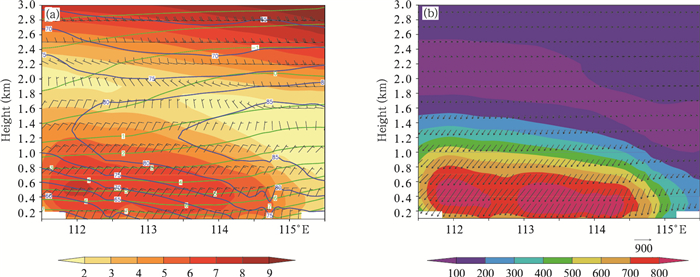
|
| 图 7 湖北重污染过程模拟合成的沿30.5°N的风速(风矢与色阶,单位:m/s)、温度(绿色等值线,单位:℃)和相对湿度(蓝色等值线,单位:%)垂直剖面(a)及PM2.5传输通量(单位:μg/(m2·s))垂直剖面(b) Figure 7 Vertical-meridional cross sections of simulated synthesis of wind speed (barbed arrow and shadings, unit: m/s), temperature (green contour lines, unit: ℃) and relative humidity (blue contour lines, unit: %) (a) and the PM2.5 transport flux (unit: μg/m2·s) (b) along 30.5°N during heavy pollution process in Hubei province |
风场垂直结构模拟与图 2风廓线雷达探测结果比较吻合,与珠江三角洲Ⅱ型污染(传输型)观测也较为一致(刘健等,2015),边界层0-1 km主导东北风且风速较大,中间层有小风区,高层偏西风且风速较大。有别于华北地区爆发污染边界层结构特征,地面和低空风速较小,最大风速仅2 m/s,低层大气层结稳定,不利于空气中细颗粒物的扩散和稀释(王跃等,2014)。重污染过程边界层1 km以下风速小于3 m/s,300 m以下小于2 m/s(吴蒙等,2015)。
综上所述,湖北传输性爆发污染边界层特征为,中低层0-1 km为重要传输通道,污染传输通量极值位于400 m高度附近,以偏北方向传输为主,低空整层无明显逆温,输送条件良好。
FLEXPART粒子扩散模式向后模拟能够诊断受体城市的潜在源区,并能够量化潜在源区影响大小(Brioude, et al,2013)。根据源受关系,通过FLEXPART输出结果(敏感性系数resi),并结合排放源清单(排放强度source),能够得到目标时段内m个格点上的源对受体贡献大小(陈赛华等,2017)。采用WRF/Chem模拟结果驱动FLEXPART后向积分72 h,并合成重污染过程,同时考虑气象输送条件和区域排放源分布,分析湖北地区大气污染潜在源区贡献分布。
图 8给出江汉平原和鄂东受体点重污染过程大气污染潜在源区贡献分布。可见湖北地区传输性污染主要来自偏北和东北方向潜在源区贡献,江汉平原传输性污染来自偏北通道上河南中部、南阳盆地和关中地区污染源输送,鄂东传输性污染来自东北通道上山东、江苏和安徽部分地区污染源输送。

|
| 图 8 江汉平原(a)、鄂东(b)受体点重污染过程大气污染潜在源区贡献分布 Figure 8 Distributions of potential source of atmospheric pollutants in the Jianghan Plain (a) and eastern Hubei (b) |
图 9分别给出湖北省实况PM2.5浓度、10 m风速V分量及模拟PM2.5输送(non-local sources)和模拟V分量的日变化特征。可见,PM2.5日变化为明显双峰结构,峰值发生在晚间21-24时和日间11-14时。日落后大气层结相对稳定,近地面风速较小,有利污染物堆积,PM2.5浓度达到峰值。日出后北风风速增大,携外来污染物输送入境,PM2.5浓度出现另一个峰值。PM2.5(non-local sources)模拟结果对日间污染输送做了验证,PM2.5输送在日间09-12时出现峰值(时间偏差与V分量模拟偏差有关),这表明日间浓度峰值是与北风携外来污染物输送有关。

|
| 图 9 2015年12月2日-2016年1月31日湖北实况PM2.5浓度和10 m风速V分量(a)、及模拟PM2.5输送浓度(non-local sources)和10 m风速V分量(b)日变化 Figure 9 Diurnal variation characteristics of observed PM2.5 concentration and meridional component of 10 m wind (a), and simulated PM2.5 transport concentration (non-local sources) and meridional component of 10 m wind (b) in Hubei Province from 2 December 2015 to 31 January 2016 |
图 10模拟出襄阳、荆州PM2.5输送(non-local sources)及气象要素的边界层日变化特征。可见边界层受偏北风控制,外来污染物由南阳盆地向江汉平原输送,襄阳为北路传输通道入口,日出前大气边界层高度(PBLH)较低,600 m以内为等温层结,整层伴有上升运动,这使得上空污染输送被限制向下沉降,在边界层顶部400 m高度附近堆积形成极值中心,继续向江汉平原传输。荆门PM2.5输送量减少,时间滞后,日出前大气边界层高度较低,低空为等温层结,有弱上升运动,污染输送也在边界层顶部400 m附近滞留堆积。日出后,随边界层逐渐发展升高,等温层结和上升运动被破坏,在干沉降作用下,400 m处高浓度PM2.5开始向下传输,并与本地污染源叠加,形成地面观测到的PM2.5午后浓度峰值。

|
| 图 10 2015年12月2日-2016年1月31日模拟襄阳(a)、荆州(b)边界层PM2.5输送浓度(non-local sources)(色阶,单位:μg/m3)、水平风速(矢线,单位:m/s)、气温(白色等值线,单位:℃)和垂直速度(黑色等值线,单位:m/s)的日变化特征 Figure 10 Diurnal variation characteristics of the simulated PM2.5 transport concentration (non-local sources) (shadings, unit: μg/m3), horizontal winds (vectors, unit: m/s), temperature (white contour lines, unit: m/s), and vertical velocity (black contour lines, unit: m/s) in the boundary layer in Xiangyang (a) and Jingzhou (b) from 2 December 2015 to 31 January 2016 |
同时考虑10 m风速U、V分量变化对PM2.5浓度的影响,采用多变量经验正交函数(MV-EOF)分解方法对湖北17个城市实况PM2.5浓度、U分量、V分量逐时样本提取主要成分,第1特征向量(MPC1)、第2特征向量(MPC2)方差贡献分别为29%、27%,与仅提取PM2.5浓度的第1主成分方差贡献58%相当,代表了湖北污染主要信息。
图 11给出第1、第2特征向量的时间序列日变化及模拟湖北大气边界层高度日变化特征。可见提取的前2个特征向量日变化信息恰好指示出PM2.5浓度日变化的双峰结构,第1特征向量对应日间峰值,并且与大气边界层高度日变化特征相吻合,表明地面风携外来污染物输送是受大气边界层高度发展影响,日间11-14时随大气边界层高度升高,在低空聚集的外来污染物开始向地面沉降输送,在午后地面形成浓度峰值。第2特征向量对应晚间峰值特征,21-24时大气边界层高度降低,层结稳定,风速较小,利于污染堆积,使PM2.5达到峰值。

|
| 图 11 第1、第2特征向量时间序列日变化及模拟湖北大气边界层高度日变化特征 Figure 11 Diurnal variation characteristics of the temporal coefficients of the first and second eigenvectors (MPC1, MPC2), and simulated boundary layer height (PBLH) (unit: m) in Hubei |
图 12给出第1、第2特征向量分布,反映局地风速相互作用对PM2.5浓度的影响。第1特征向量表示传输性污染,日间,PM2.5输送向江汉平原堆积,襄阳、随州以北风输送为主,江汉平原、武汉以东北风输送为主,黄石、黄冈、鄂州以局地西北风输送为主(受武汉排放源影响)。第2特征向量表示静稳性污染,夜间,污染主要在东部地区聚集,局地东南风和西南风利于污染堆积。

|
| 图 12 第1(a)、第2(b)特征向量对应PM2.5浓度(色阶)和10 m风速U、V合成矢量的特征向量空间分布 Figure 12 Distributions of the first (a) and second (b) eigenvector fields (MPC1, MPC2) of PM2.5 (shadings) and 10 m wind vector synthesis with U and V components |
筛选大于1.5倍标准差的标准化第1、第2特征向量时间序列样本序号,对WRF/Chem模拟结果进行合成。图 13给出模式合成第1和第2特征向量地面天气形势,可见第1特征向量模态南北方向有一定的气压梯度,偏北风异常偏强,大气边界层高度正距平利于污染输送,为典型传输型天气形势。第2特征向量模态为均压场,大气边界层高度负距平,异常偏南风利于污染堆积,为典型静稳型天气形势。模拟结果很好验证了第1、第2特征向量污染特征。
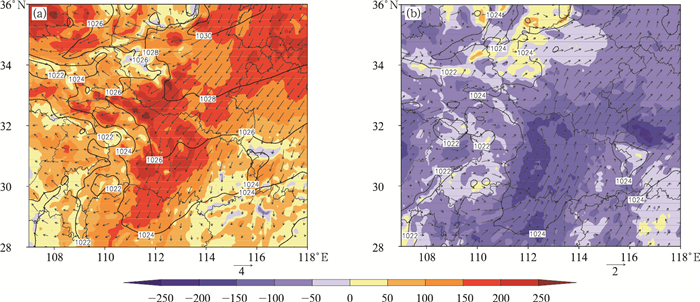
|
| 图 13 模拟合成第1(a)、第2(b)特征向量大气边界层高度距平(色阶,单位:m)、海平面气压(等值线,单位:hPa)及10 m异常风速场(矢线,单位:m/s) Figure 13 Simulated synthesis of PBLH anomaly (shadings, unit: m), sea level pressure (contours, unit: hPa) and 10 m wind speed anomaly (vectors, unit: m/s) of the MPC1 (a) and MPC2 (b) |
综上所述,PM2.5浓度日变化双峰结构的成因不同,21-24时峰值为静稳性污染,11-14时峰值为传输性污染。PM2.5输送受大气边界层高度影响,日出前边界层较低,层结稳定并伴有上升运行,使得低空外来输送悬浮聚集在400 m高度附近,日出后随大气边界层高度升高,静稳层结被破坏,在干沉降作用下高浓度PM2.5开始向下传输,并在午后地面形成峰值。局地风的相互作用对湖北污染输送和累积有一定影响,日间偏北风利于污染输送,晚间偏南风利于污染堆积。
5 结论和讨论(1) 湖北2015/2016年冬季以传输性爆发污染为主,具有“非静稳”边界层气象特征,中低层0-1 km为重要传输通道,污染传输通量极值位于400 m高度附近,以偏北方向输送为主,低空整层无明显逆温,输送条件良好。边界层风场有3层垂直结构特征,中低层和近地面层为较强偏北风,PM2.5浓度极值对应10 m风速可达8-10 m/s,有别于华北地区重污染“静稳”边界层气象特征。
(2) 湖北重污染形成的大尺度输送条件为,长江中下游及北部地区偏北风异常偏强,长江中游以南地区风速减缓,使污染物在中游平原堆积,鄂北边界风速越大,越有利污染输送增长。湖北传输性污染主要来自偏北和东北方向的污染输送,潜在源区贡献主要为途经偏北通道上的豫中、南阳盆地和关中地区及途经东北通道上的鲁、皖、苏等部分地区。
(3) 湖北PM2.5浓度日变化双峰结构的天气成因不同,21-24时峰值为静稳性污染,11-14时峰值为传输性污染。污染输送受大气边界层高度影响,日出前大气边界层高度较低,层结稳定并伴有上升运行,使得低空外来输送悬浮聚集在400 m高度附近,日出后随大气边界层高度升高,静稳层结被破坏,在干沉降作用下高浓度PM2.5开始向下传输,并在午后地面形成峰值。局地风的相互作用对污染输送和累积有一定影响,日间偏北风利于污染输送,晚间偏南风利于污染堆积。
需要指出的是,文中只是对2015年12月-2016年1月湖北污染过程的模拟分析,没有涉及历史事件的诊断,未来尚需长时间观测和模拟对湖北冬季以传输性爆发污染为主的结论进行验证。但该地区重污染过程表现出的“非静稳”边界层气象条件值得关注,有必要研究和规范地方传输性爆发空气污染气象条件的预报技术指标。此外,用小范围零排放方案估算排放源对大气污染的贡献,同实际大气中污染物与大气的相互作用不一致,会存在不确定性。
致谢: 感谢中国气象科学研究院郭建平研究员为本文初稿提出的改进意见。| 安静宇, 李莉, 黄成, 等. 2014. 2013年1月中国东部地区重污染过程中上海市细颗粒物的来源追踪模拟研究. 环境科学学报, 34(10): 2635–2644. An J Y, Li L, Huang C, et al. 2014. Source apportionment of the fine particulate matter in Shanghai during the heavy haze episode in eastern China in January 2013. Acta Sci Circum, 34(10): 2635–2644. (in Chinese) |
| 白永清, 祁海霞, 刘琳, 等. 2016a. 武汉大气能见度与PM2.5浓度及相对湿度关系的非线性分析及能见度预报. 气象学报, 74(2): 189–199. Bai Y Q, Qi H X, Liu L, et al. 2016a. Study on the nonlinear relationship among the visibility, PM2.5 concentration and relative humidity in Wuhan and the visibility prediction. Acta Meteor Sinica, 74(2): 189–199. (in Chinese) |
| 白永清, 祁海霞, 刘琳, 等. 2016b. 华中区域环境气象数值预报系统及其初步应用. 高原气象, 35(6): 1671–1682. Bai Y Q, Qi H X, Liu L, et al. 2016b. Development and preliminary application of environmental meteorology numerical model system in central China. Plateau Meteor, 35(6): 1671–1682. (in Chinese) |
| 陈赛华, 周广强, 朱彬, 等. 2017. 一种快速定量估计大气污染物来源的方法. 环境科学学报, 37(7): 2474–2481. Chen S H, Zhou G Q, Zhu B, et al. 2017. A method for fast quantification of air pollutant sources. Acta Sci Circum, 37(7): 2474–2481. (in Chinese) |
| 贾星灿, 郭学良. 2012. 人为大气污染物对一次冬季浓雾形成发展的影响研究. 大气科学, 36(5): 995–1008. Jia X C, Guo X L. 2012. Impacts of anthropogenic atmospheric pollutant on formation and development of a winter heavy fog event. Chin J Atmos Sci, 36(5): 995–1008. (in Chinese) |
| 蒋永成, 赵天良, 王宏, 等. 2015. 福州市PM2.5污染过程中大气边界层和区域传输研究. 中国环境科学, 35(2): 347–355. Jiang Y C, Zhao T L, Wang H, et al. 2015. Analysis on atmospheric boundary layer and regional transport during PM2.5 pollution episodes in Fuzhou. China Environ Sci, 35(2): 347–355. (in Chinese) |
| 李嘉伟, 韩志伟. 2016. 中国东部气溶胶光学厚度季节变化的数值模拟. 遥感学报, 20(2): 205–215. Li J W, Han Z W. 2016. Numerical simulation of the seasonal variation of aerosol optical depth over eastern China. J Remote Sens, 20(2): 205–215. (in Chinese) |
| 李莉, 蔡鋆琳, 周敏. 2015. 2013年12月中国中东部地区严重灰霾期间上海市颗粒物的输送途径及潜在源区贡献分析. 环境科学, 36(7): 2327–2336. Li L, Cai J L, Zhou M. 2015. Potential source contribution analysis of the particulate matters in shanghai during the heavy haze episode in eastern and middle China in December, 2013. Environ Sci, 36(7): 2327–2336. (in Chinese) |
| 刘建, 吴兑, 范绍佳. 2015. 珠江三角洲区域污染分布及其垂直风场特征. 环境科学, 36(11): 3989–3998. Liu J, Wu D, Fan S J. 2015. Distribution of regional pollution and the characteristics of vertical wind field in the Pearl River Delta. Environ Sci, 36(11): 3989–3998. (in Chinese) |
| 刘瑞金, 廖宏, 常文渊, 等. 2017. 基于国际大气化学-气候模式比较计划模式数据评估未来气候变化对中国东部气溶胶浓度的影响. 大气科学, 41(4): 739–751. Liu R J, Liao H, Chang W Y, et al. 2017. Impact of climate change on aerosol concentrations in eastern China based on atmospheric chemistry and climate model intercomparison project (ACCMIP) datasets. Chin J Atmos Sci, 41(4): 739–751. (in Chinese) |
| 缪育聪, 郑亦佳, 王姝, 等. 2015. 京津冀地区霾成因机制研究进展与展望. 气候与环境研究, 20(3): 356–368. Miao Y C, Zheng Y J, Wang S, et al. 2015. Recent advances in, and future prospects of, research on haze formation over Beijing-Tianjin-Hebei, China. Climatic Environ Res, 20(3): 356–368. (in Chinese) |
| 石春娥, 张浩, 弓中强, 等. 2017. 2013-2015年合肥市PM2.5重污染特征研究. 气象学报, 75(4): 632–644. Shi C E, Zhang H, Gong Z Q, et al. 2017. Characteristics of severe PM2.5 pollution in Hefei during 2013-2015. Acta Meteor Sinica, 75(4): 632–644. (in Chinese) |
| 苏福庆, 高庆先, 张志刚, 等. 2004. 北京边界层外来污染物输送通道. 环境科学研究, 17(1): 26–29. Su F Q, Gao Q X, Zhang Z G, et al. 2004. Transport pathways of pollutants from outside in atmosphere boundary layer. Research of Environmental Sciences, 17(1): 26–29. DOI:10.3321/j.issn:1001-6929.2004.01.005 (in Chinese) |
| 谭成好, 赵天良, 崔春光, 等. 2015. 近50年华中地区霾污染的特征. 中国环境科学, 35(8): 2272–2280. Tan C H, Zhao T L, Cui C G, et al. 2015. Characterization of haze pollution over Central China during the past 50 years. China Environ Sci, 35(8): 2272–2280. (in Chinese) |
| 王继康, 花丛, 桂海林, 等. 2017. 2016年1月我国中东部一次大气污染物传输过程分析. 气象, 43(7): 804–812. Wang J K, Hua C, Gui H L, et al. 2017. Transport of PM2.5 of the haze pollution episode over mid-eastern China in January 2016. Meteor Mon, 43(7): 804–812. (in Chinese) |
| 王跃, 王莉莉, 赵广娜, 等. 2014. 北京冬季PM2.5重污染时段不同尺度环流形势及边界层结构分析. 气候与环境研究, 19(2): 173–184. Wang Y, Wang L L, Zhao G N, et al. 2014. Analysis of different-scales circulation patterns and boundary layer structure of PM2.5 heavy pollutions in Beijing during winter. Climatic Environ Res, 19(2): 173–184. (in Chinese) |
| 王跃思, 姚利, 王莉莉, 等. 2014. 2013年元月我国中东部地区强霾污染成因分析. 中国科学:地球科学, 57(1): 14–25. Wang Y S, Yao L, Wang L L, et al. 2014. Mechanism for the formation of the January 2013 heavy haze pollution episode over central and eastern China. Sci China Earth Sci, 57(1): 14–25. (in Chinese) |
| 王自发, 李杰, 王哲, 等. 2014. 2013年1月我国中东部强霾污染的数值模拟和防控对策. 中国科学:地球科学, 57(1): 3–13. Wang Z F, Li J, Wang Z, et al. 2014. Modeling study of regional severe hazes over Mid-Eastern China in January 2013 and its implications on pollution prevention and control. Sci China Earth Sci, 57(1): 3–13. (in Chinese) |
| 尉鹏, 任阵海, 王文杰, 等. 2015. 2014年10月中国东部持续重污染天气成因分析. 环境科学研究, 28(5): 676–683. Wei P, Ren Z H, Wang W J, et al. 2015. Analysis of meteorological conditions and formation mechanisms of lasting heavy air pollution in eastern China in October 2014. Res Environ Sci, 28(5): 676–683. (in Chinese) |
| 吴兑, 吴晟, 李海燕, 等. 2011. 穗港晴沙两重天:2010年3月17-23日珠三角典型灰霾过程分析. 环境科学学报, 31(4): 695–703. Wu D, Wu C, Li H Y, et al. 2011. Dusty sky in Hong Kong and clear sky in the inland of the Pearl River Delta:Analysis of a typical haze episode during 17-23 March 2010. Acta Sci Circum, 31(4): 695–703. (in Chinese) |
| 吴兑. 2012. 近十年中国灰霾天气研究综述. 环境科学学报, 32(2): 257–269. Wu D. 2012. Hazy weather research in China in the last decade:A review. Acta Sci Circum, 32(2): 257–269. (in Chinese) |
| 吴兑, 廖碧婷, 吴蒙, 等. 2014. 环首都圈霾和雾的长期变化特征与典型个例的近地层输送条件. 环境科学学报, 34(1): 1–11. Wu D, Liao B T, Wu M, et al. 2014. The long-term trend of haze and fog days and the surface layer transport conditions under haze weather in North China. Acta Sci Circum, 34(1): 1–11. (in Chinese) |
| 吴蒙, 吴兑, 范绍佳. 2015. 基于风廓线仪等资料的珠江三角洲污染气象条件研究. 环境科学学报, 35(3): 619–626. Wu M, Wu D, Fan S J. 2015. Meteorological condition associated with poor air quality over Pearl River Delta based on the data of radar wind profiler. Acta Sci Circum, 35(3): 619–626. (in Chinese) |
| 徐祥德, 周秀骥, 施晓晖. 2005. 城市群落大气污染源影响的空间结构及尺度特征. 中国科学D辑:地球科学, 35(S1): 1–19. Xu X D, Zhou X J, Shi X H. 2005. Spatial structure and scale feature of the atmospheric pollution source impact of city agglomeration. Sci China Ser D Earth Sci, 35(S1): 1–19. (in Chinese) |
| 徐祥德, 王寅钧, 赵天良, 等. 2015. 中国大地形东侧霾空间分布"避风港"效应及其"气候调节"影响下的年代际变异. 科学通报, 60(12): 1132–1143. Xu X D, Wang Y J, Zhao T L, et al. 2015. "Harbor" effect of large topography on haze distribution in eastern China and its climate modulation on decadal variations in haze China. Chinese Sci Bull, 60(12): 1132–1143. (in Chinese) |
| 薛文博, 付飞, 王金南, 等. 2014. 中国PM2.5跨区域传输特征数值模拟研究. 中国环境科学, 34(6): 1361–1368. Xue W B, Fu F, Wang J N, et al. 2014. Numerical study on the characteristics of regional transport of PM2.5 in China. China Environ Sci, 34(6): 1361–1368. (in Chinese) |
| 姚日升, 涂小萍, 张小伟, 等. 2017. 宁波一次罕见持续重度污染事件的成因分析. 气象学报, 75(2): 342–355. Yao R S, Tu X P, Zhang X W, et al. 2017. Analysis on a rare persistent heavy pollution event in Ningbo. Acta Meteor Sinica, 75(2): 342–355. (in Chinese) |
| 张人禾, 李强, 张若楠. 2014. 2013年1月中国东部持续性强雾霾天气产生的气象条件分析. 中国科学:地球科学, 57(1): 26–35. Zhang R H, Li Q, Zhang R N. 2014. Meteorological conditions for the persistent severe fog and haze event over eastern China in January 2013. Sci China Earth Sci, 57(1): 26–35. (in Chinese) |
| 张小曳, 孙俊英, 王亚强, 等. 2013. 我国雾-霾成因及其治理的思考. 科学通报, 58(13): 1178–1187. Zhang X Y, Sun J Y, Wang Y Q, et al. 2013. Factors contributing to haze and fog in China. Chinese Sci Bull, 58(13): 1178–1187. (in Chinese) |
| 张雅斌, 林琳, 吴其重, 等. 2016. "13·12"西安重污染气象条件及影响因素. 应用气象学报, 27(1): 35–46. Zhang Y B, Lin L, Wu Q Z, et al. 2016. Meteorological conditions and impact factors of a heavy air pollution process at Xi'an in December 2013. J Appl Meteor Sci, 27(1): 35–46. (in Chinese) |
| 赵晨曦, 王云琦, 王玉杰, 等. 2014. 北京地区冬春PM2.5和PM10污染水平时空分布及其与气象条件的关系. 环境科学, 35(2): 418–427. Zhao C X, Wang Y Q, Wang Y J, et al. 2014. Temporal and spatial distribution of PM2.5 and PM10 pollution status and the correlation of particulate matters and meteorological factors during winter and spring in Beijing. Environ Sci, 35(2): 418–427. (in Chinese) |
| 赵秀娟, 徐敬, 张自银, 等. 2016. 北京区域环境气象数值预报系统及PM2.5预报检验. 应用气象学报, 27(2): 160–172. Zhao X J, Xu J, Zhang Z Y, et al. 2016. Beijing regional environmental meteorology prediction system and its performance test of PM2.5 concentration. J Appl Meteor Sci, 27(2): 160–172. (in Chinese) |
| 周广强, 谢英, 吴剑斌, 等. 2016. 基于WRF-Chem模式的华东区域PM2.5预报及偏差原因. 中国环境科学, 36(8): 2251–2259. Zhou G Q, Xie Y, Wu J B, et al. 2016. WRF-Chem based PM2.5 forecast and bias analysis over the East China Region. China Environ Sci, 36(8): 2251–2259. (in Chinese) |
| 周述学, 王兴, 弓中强, 等. 2017. 长江三角洲西部地区PM2.5输送轨迹分类研究. 气象学报, 75(6): 996–1010. Zhou S X, Wang X, Gong Z Q, et al. 2017. Transport patterns of PM2.5 in the western Yangtze River Delta district, China. Acta Meteor Sinica, 75(6): 996–1010. (in Chinese) |
| Brioude J, Arnold D, Stohl A, et al. 2013. The Lagrangian particle dispersion model FLEXPART-WRF version 3.1. Geosci Model Dev, 6(6): 1889–1904. DOI:10.5194/gmd-6-1889-2013 |
| Chen F, Dudhia J. 2001. Coupling an advanced land surface-hydrology model with the Penn State-NCAR MM5 modeling system. Part Ⅰ:model implementation and sensitivity. Mon Wea Rev, 129(4): 569–585. DOI:10.1175/1520-0493(2001)129<0569:CAALSH>2.0.CO;2 |
| Ding Y H, Liu Y J. 2014. Analysis of long-term variations of fog and haze in China in recent 50 years and their relations with atmospheric humidity. Sci China Earth Sci, 57(1): 36–46. DOI:10.1007/s11430-013-4792-1 |
| Grell G A, Peckham S E, Schmitz R, et al. 2005. Fully coupled "online" chemistry within the WRF model. Atmos Environ, 39(37): 6957–6975. DOI:10.1016/j.atmosenv.2005.04.027 |
| Guo J P, He J, Liu H L, et al. 2016. Impact of various emission control schemes on air quality using WRF-Chem during APEC China 2014. Atmos Environ, 140: 311–319. DOI:10.1016/j.atmosenv.2016.05.046 |
| Guo J P, Lou M Y, Miao Y C, et al. 2017. Trans-Pacific transport of dust aerosols from East Asia:Insights gained from multiple observations and modeling. Environ Poll, 230: 1030–1039. DOI:10.1016/j.envpol.2017.07.062 |
| Hong S Y, Noh Y, Dudhia J. 2006. A new vertical diffusion package with an explicit treatment of entrainment processes. Mon Wea Rev, 134(9): 2318–2341. DOI:10.1175/MWR3199.1 |
| Hu Y, Balachandran S, Pachon J E, et al. 2014. Fine particulate matter source apportionment using a hybrid chemical transport and receptor model approach. Atmos Chem Phys, 14(11): 5415–5431. DOI:10.5194/acp-14-5415-2014 |
| Hu Y T, Odman M T, Chang M E, et al. 2015. Operational forecasting of source impacts for dynamic air quality management. Atmos Environ, 116: 320–322. DOI:10.1016/j.atmosenv.2015.04.061 |
| Iacono M J, Delamere J S, Mlawer E J, et al. 2008. Radiative forcing by long-lived greenhouse gases:Calculations with the AER radiative transfer models. J Geophys Res, 113(D13): D13103. DOI:10.1029/2008JD009944 |
| Kan H, Chen R J, Tong S L. 2012. Ambient air pollution, climate change, and population health in China. Environ Int, 42: 10–19. DOI:10.1016/j.envint.2011.03.003 |
| Kim C H, Park S Y, Kim Y J, et al. 2012. A numerical study on indicators of long-range transport potential for anthropogenic particulate matters over northeast Asia. Atmos Environ, 58: 35–44. DOI:10.1016/j.atmosenv.2011.11.002 |
| Kumar R, Barth M C, Pfister G G, et al. 2014. WRF-Chem simulations of a typical pre-monsoon dust storm in northern India:Influences on aerosol optical properties and radiation budget. Atmos Chem Phys, 14(5): 2431–2446. DOI:10.5194/acp-14-2431-2014 |
| Lang J L, Cheng S Y, Li J B, et al. 2013. A monitoring and modeling study to investigate regional transport and characteristics of PM2.5 pollution. Aerosol Air Qual Res, 13(3): 943–956. DOI:10.4209/aaqr.2012.09.0242 |
| Li M, Zhang Q, Kurokawa J, et al. 2015. MIX:A mosaic Asian anthropogenic emission inventory for the MICS-Asia and the HTAP projects. Atmos Chem Phys Discuss, 15(23): 34813–34869. DOI:10.5194/acpd-15-34813-2015 |
| Miao Y C, Guo J P, Liu S H, et al. 2017. Classification of summertime synoptic patterns in Beijing and their associations with boundary layer structure affecting aerosol pollution. Atmos Chem Phys, 17(4): 3097–3110. DOI:10.5194/acp-17-3097-2017 |
| Squizzato S, Masiol M, Innocente E, et al. 2012. A procedure to assess local and long-range transport contributions to PM2.5 and secondary inorganic aerosol. J Aerosol Sci, 46: 64–76. DOI:10.1016/j.jaerosci.2011.12.001 |
| Tai A P K, Mickley L J, Jacob D J. 2012. Impact of 2000-2050 climate change on fine particulate matter (PM2.5) air quality inferred from a multi-model analysis of meteorological modes. Atmos Chem Phys, 12(23): 11329–11337. DOI:10.5194/acp-12-11329-2012 |
| Wu J, Guo J, Zhao D M. 2013. Characteristics of aerosol transport and distribution in East Asia. Atmos Res, 132-133: 185–198. DOI:10.1016/j.atmosres.2013.05.018 |
| Xing J, Zhang Y, Wang S X, et al. 2011. Modeling study on the air quality impacts from emission reductions and atypical meteorological conditions during the 2008 Beijing Olympics. Atmos Environ, 45(10): 1786–1798. DOI:10.1016/j.atmosenv.2011.01.025 |
| Zhang L, Wang T, Lv M Y, et al. 2015. On the severe haze in Beijing during January 2013:Unraveling the effects of meteorological anomalies with WRF-Chem. Atmos Environ, 104: 11–21. DOI:10.1016/j.atmosenv.2015.01.001 |
| Zhang X Y, Wang Y Q, Niu T, et al. 2012. Atmospheric aerosol compositions in China:Spatial/temporal variability, chemical signature, regional haze distribution and comparisons with global aerosols. Atmos Chem Phys, 12(2): 779–799. DOI:10.5194/acp-12-779-2012 |
| Zheng B, Zhang Q, Zhang Y, et al. 2015. Heterogeneous chemistry:A mechanism missing in current models to explain secondary inorganic aerosol formation during the January 2013 haze episode in North China. Atmos Chem Phys, 15(4): 2031–2049. DOI:10.5194/acp-15-2031-2015 |
| Zhong M, Saikawa E, Liu Y, et al. 2016. Air quality modeling with WRF-Chem v3.5 in East Asia:Sensitivity to emissions and evaluation of simulated air quality. Geosci Model Dev Discuss, 9(3): 1201–1218. DOI:10.5194/gmd-9-1201-2016 |
| Zhu J L, Liao H, Li J P. 2012. Increases in aerosol concentrations over eastern China due to the decadal-scale weakening of the East Asian summer monsoon. Geophys Res Lett, 39(9): L09809. |
 2018, Vol. 76
2018, Vol. 76

